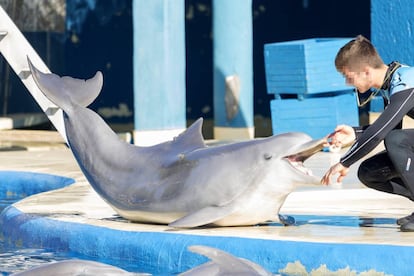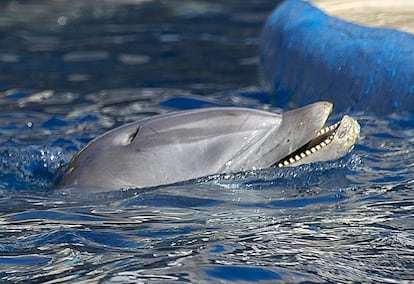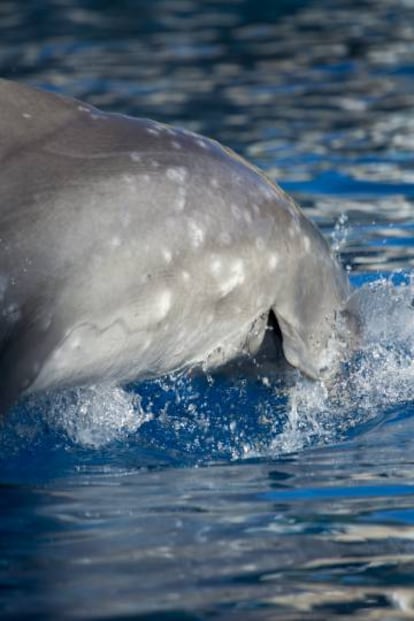Complaint claims abusive conditions for dolphins at Madrid Zoo
The Civil Guard nature protection service has received a vet’s report analyzing the health of nine animals at the popular theme park in the Spanish capital

It is a normal Friday afternoon at Madrid’s Zoo Aquarium. Three trainers in wetsuits move to the rhythm of the music while a woman’s voice comes over the loudspeaker with a range of dolphin facts. She speaks about their intelligence, their anatomy, their habits and the smile that never leaves their faces. She also talks about the threats they face in the wild. And then she asks for silence. “Can you hear that?” she asks. The high-pitched sounds from these cetaceans prompt applause from the children and their parents. The dolphins are funny.
After an hour, the music stops and the woman bids the visitors goodbye while the dolphins sink under the surface of the semi-circular pool they inhabit 24/7. They withdraw with their ever-present smiles that are not smiles at all. The fact is, even if they were sad, they would appear to be grinning. A veterinary report sent to Seprona – the nature protection arm of the Spanish Civil Guard – concludes that the nine dolphins at Madrid Zoo Aquarium are, in fact, sick. They have eye problems and two of them, Lala and Guarina, have skin lesions.
Seprona has accepted a complaint by a Spanish association called Proyecto Gran Simio (or, Project Great Ape) based on this vet’s report. This group carried out an investigation named Operation 404, under the sponsorship of the international organization Sea Shepherd Conservation Society. The investigation focused on the consequences of keeping animals in captivity, with the Madrid dolphins being a case in point.

Pedro Pozas, the executive director of Proyecto Gran Simio, handed photos to the law-enforcement service together with a video and a summary of conclusions by the vet Agustín González, who is an expert in wild marine animals, with 15 years of experience working with cetaceans in the Canary Islands. “I saw the vet’s report and my heart sank,” says Pozas. “So we decided to file a formal complaint as representatives of an animal-welfare organization.”
The vet’s report concluded that the nine bottlenose dolphins are sick as a consequence of being kept in captivity, although the main focus is on two named Lala and Guarina. All of them have eye problems, probably due to constant contact with chlorine, while the latter two also have skin conditions.
“In the photos, you can clearly see that one has her whole body covered by an ulcerous dermatological condition that shows up in the form of craters,” says Pozas. “The lesions go from the head to the back, as far as the tail fin. They measure several centimeters in diameter and are in different phases of development, from inflammation, swelling, erythema and lumps to deep ulcers.”
The findings have reignited the debate on whether or not it is ethical to breed animals in the captivity of a swimming pool when their natural habitat is the open sea. As far as the animal-welfare association is concerned, it is nothing short of abuse. But managers at the Madrid Zoo Aquarium believe the allegations are unjust and that the educational, conservationist and research aspects of their work have not been taken into account.

But vet González is categorical about his stance. “It’s barbaric,” he says. “Dolphins swim an average of 100 kilometers a day in the wild. They do a lot of exercise. When they are in captivity, they go round and round the swimming pool and they live all day in the place where they eat and defecate. They need to clean the water with chlorine because they live submerged in bacteria. That is why they keep their eyes closed.”
González goes on to explain that dolphins are very choosy about who they spend time with. They pick their own groups, which number around 80, and they communicate using high-pitched sounds that, according to the vet, bounce off the walls of the swimming pool and drive them mad.
González is currently working in a veterinary center in Málaga with domestic animals but he still feels deeply disturbed by the images of these dolphins in captivity. “Lala is covered in ulcers,” he says. “It’s obviously a skin disease. You can see that some of her lesions have gotten better and others are just beginning to emerge and that is very painful because dolphins’ skins are very sensitive. Ideally, you would perform a biopsy and, of course, stop them from working. Because when they are performing, it’s not just exercise, they are working for their food.”
According to González, Guarina’s health is also worrying. “She is missing part of her nose,” he says. “Just imagine, dolphins don’t have hands; they use their noses for touch and it is as though [her nose] was raw. That could be because of a scrape with a wetsuit or banging against the walls of the swimming pool.”
González says he fails to understand how the public can be turned into accomplices in this “abuse,” paying the entrance fee, which costs an average of €23.85 for an adult and €19.30 for a child, particularly when you can go out on a boat in the open sea for less to observe the same animals in the wild. He believes the business runs on ignorance.
Instead of focusing on what is important, we focus on two dolphins in the aquarium that are sick. It is really unfair
Maria José Luis Cerezo, Madrid Zoo
“The big problem dolphins have is that they always look as though they are happy because their anatomy gives them a smile,” he says. “A sad dolphin simply doesn’t look sad. I have had to put a number of dolphins to sleep who were suffering but who appeared to be happy. In fact, they express happiness by jumping and swimming, not by performing to get food. But people don’t know this. Many of them get depressed and go around in circles the whole time. Some stop eating and, what is worse, stop breathing because breathing in dolphins and whales is voluntary, the same as it is with humans. So when they don’t want to [do it], they let it go. The famous dolphin Flipper committed suicide. He couldn’t stand it anymore and he went under the water and stopped breathing voluntarily. That was triggered by captivity.”
But Madrid Zoo takes an altogether different view. They say that the animals are tended to by a team of vets and carers as well as marine conservationists and experts. “Our legal team is studying whether to file a complaint over these allegations, which are false and unfounded,” says María José Luis Cerezo, from the zoo’s press department. “Lala has a chronic skin problem. It’s a herpes virus that she could also have if she were in the wild. But we don’t hide the animals that are not so pretty. They are under veterinary care and it does them good to feel part of the group. Work? Well, what they do is not working,” she adds. “Lala is 42 and Coral, her granddaughter, won’t be separated from her and looks after her diligently. They are a very cohesive group and they are perfectly fine. I have never known people more concerned about the welfare of animals,” she adds, referring to the zoo’s marine team. “They live for them.”
According to the zoo’s spokeswoman, the aquarium is also active in conservation. “We travel to the Pacific to do research and help sustain the environment,” she says. “We have monitored a number of monk seals, for example – one of the most endangered mammals on the planet, off the coast of Mauritania. This was done for research purposes and to help conserve them. But no one mentions that. Instead of focusing on what is important, we focus on two dolphins in the aquarium that are sick. It is really unfair.”
Luis Cerezo insists that the purpose of the aquarium is educational. “We give talks,” she says. “We speak about the biology of the animal, the threats it is under and what we can do about them. We offer an educational, research and conservation service. The animals are well looked after, they eat first-class fish and each carer controls their diet. They don’t lack for anything.”
However, as González points out, they lack their freedom.
English version by Heather Galloway.
Tu suscripción se está usando en otro dispositivo
¿Quieres añadir otro usuario a tu suscripción?
Si continúas leyendo en este dispositivo, no se podrá leer en el otro.
FlechaTu suscripción se está usando en otro dispositivo y solo puedes acceder a EL PAÍS desde un dispositivo a la vez.
Si quieres compartir tu cuenta, cambia tu suscripción a la modalidad Premium, así podrás añadir otro usuario. Cada uno accederá con su propia cuenta de email, lo que os permitirá personalizar vuestra experiencia en EL PAÍS.
¿Tienes una suscripción de empresa? Accede aquí para contratar más cuentas.
En el caso de no saber quién está usando tu cuenta, te recomendamos cambiar tu contraseña aquí.
Si decides continuar compartiendo tu cuenta, este mensaje se mostrará en tu dispositivo y en el de la otra persona que está usando tu cuenta de forma indefinida, afectando a tu experiencia de lectura. Puedes consultar aquí los términos y condiciones de la suscripción digital.
More information
Archived In
Últimas noticias
Maduro pleads not guilty before the federal court in New York: ‘I am still the president of Venezuela’
A new test can detect Alzheimer’s from a finger prick
UN team enters Sudanese city of El Fasher after paramilitary massacre: ‘It’s like a ghost town’
A recipe for resistance: Indigenous peoples politicize their struggles from the kitchen
Most viewed
- Gilles Lipovetsky: ‘If you want to live better and fall in love, take Prozac, don’t look to philosophy’
- Alain Aspect, Nobel laureate in physics: ‘Einstein was so smart that he would have had to recognize quantum entanglement’
- Alvin Hellerstein, a 92-year-old judge appointed by Bill Clinton, to preside over Maduro’s trial in New York
- Maduro’s downfall puts China’s relationship with Venezuela to the test
- Why oil has been at the center of Venezuela-US conflicts for decades











































